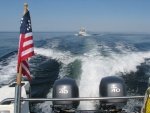T.R. Bauer
Active member
- Joined
- Nov 17, 2007
- Messages
- 1,809
- Reaction score
- 1
- C Dory Year
- 1993
- C Dory Model
- 22 Cruiser
- Vessel Name
- C-Whisperer
Spike":1m0t5230 said:As I have a single 115 and kicker it really does not pertain to me, but I am interested. How do you adjust "toe" on an outboard? Thanks
You don't with a single, but it looks like you get that. On twins you can adjust the bracket (at least on mine) to make them so the are not perfectly parallel with one another.

